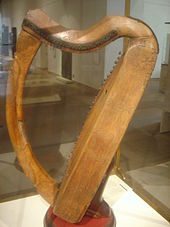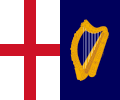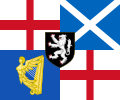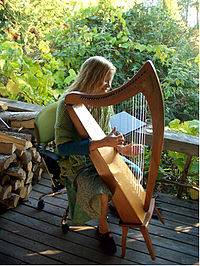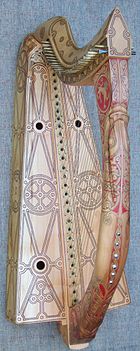- Clàrsach
-
Clàrsach or Cláirseach (depending on Scottish Gaelic or Irish spellings), is the generic Gaelic word for 'a harp', as derived from Middle Irish. In English, the word is used to refer specifically to a variety of small Irish and Scottish harps.
The use of this word in English, and the varieties of harps that it describes, is very complex and is a cause of arguments or disagreements between different groups of harp-lovers.
By and large, in English, the word clàrsach is equivalent to the term Irish harp, the former being preferred in Scottish contexts and the latter in Irish contexts. The less specific term Celtic harp has also come into use since the mid 20th century but is not preferred by Irish or Scottish natives to refer to their instruments.
The precise Gaelic term for the harp of the Gael is clàrsach Ghàidhealach (Sc.)/cláirseach Ghaelach (Ir.), meaning Gaelic harp.
Contents
Gaelic words for harps
The Gaelic triangular, wire-strung harp has always been known by the feminine term cruit. (There is evidence that the term may have originally been used to describe a different stringed instrument once common throughout the British Isles, and still extant and known in Wales as a Crwth. ) By 1204, however, it was certainly known by the masculine term 'clár' (board) and, by the 14th century, by the feminine form of 'clár', i.e., 'cláirseach'.
Clàirseach/clàrsach is a compound word, feminine in gender and composed of the masculine noun 'clár' (board; harp) and the feminising suffix '-seach/-sach'. The suggestion that it is originally composed of the elements 'clár' (board) and 'soileach' (willow) is a less likely explanation as i) the 'clár soileach' term is a masculine noun phrase, leaving the change of gender to feminine unexplained, ii) the /s/ phoneme is absent from the quoted term 'chlár shoileach' (reduced to /h/ by lenition), therefore the /l/ phoneme would be more likely to form part of any contraction (e.g., *cláirleach).
The historical Gaelic harp
 Maedoc book-cover, Ireland, circa 1100 AD: the earliest unambiguous depiction of an Irish harp
Maedoc book-cover, Ireland, circa 1100 AD: the earliest unambiguous depiction of an Irish harp
The early history of the triangular frame harp in Europe is contested. However three of the four oldest authentic harps to survive are of Gaelic provenance: the Trinity College Harp preserved in Trinity College Dublin, and the Queen Mary Harp and the Lamont Harp in the National Museum of Scotland, Edinburgh.[1] All three are dated approximately to the 15th century and are considered to have been made in Argyll in South-West Scotland[2]
Distinctive features of the Gaelic harp
The characteristic features of the historical Scottish clarsach and Irish harp are the strings of metal wire, usually brass. There is no actual evidence for precious metal strings ever being used on the harp.[3] These are attached to a massive soundbox typically carved from a single log, commonly held to be of willow, although other woods including alder and polar have been identified in extant harps, a reinforced curved pillar and a substantial neck, flanked with thick brass cheek bands. Usually played with the fingernails, it produced a brilliant ringing sound.
The clarsach is also unique amongst single row triangular harps in that the first two strings tuned in the middle of the gamut were set to the same pitch. By the end of the 18th century, this unison was given in Bunting placed at G below middle C but there is evidence that middle C was previously used as an alternative position. It is possible that the left hand, which played the treble part, never played the strings below the unison; this suggestion arises from study of the information of Edward Bunting and of the Gaelic harp repertoire.
In Middle Irish, the name for this pair of unison strings was 'ni coḃlaiġiḃ' (dative plural); the meaning of the term, its etymology and the correct Irish orthography of the nominative, whether singular or plural, are all unclear. The string name may be related to the middle Irish word 'cobhlach', which appears to have represented a kind of sound but 19th century Irish harper Patrick Byrne stated that the term meant 'the companions', an etymology which would apparently contradict the ancient spelling 'coblaigib'. In English, the unison strings were called 'the Sisters' but this is not apparently a translation of the Irish term.
Existing examples
Three medieval Gaelic harps survived into the modern period, two from Scotland (the Queen Mary Harp and the Lamont Harp) and one in Ireland (the Trinity College harp, sometimes romantically called the Brian Boru harp). Artistic evidence from study of the decorative designs on the instruments implies that all three were probably made in the western Highlands.[4] Opportunities for the Trinity harp to travel across the Irish Sea from Scotland into Ireland were, many, varied, and extremely colourful.[2] There are at least 15 other early Gaelic harps dating from post medieval times to c.1800; though most are in Ireland and are usually assumed to be Irish, many have no provenance and could equally be of Scottish origin.[5]
Importance in society
Until the end of the Middle Ages the Gaelic harp (the historical clarsach or Irish harp) was the highest status musical instrument of both Scotland and Ireland, and harpers were amongst the most prestigious cultural figures amongst Irish and Scottish kings and chiefs. In both countries, the harper enjoyed special rights and played a crucial part in ceremonial occasions such as coronation and poetic recital.
The main function of the Gaelic harp in medieval Scotland and Ireland seems to have been playing to accompany the recitation of poetry in Gaelic or Irish.
Especially popular in 16th and 17th century English courts, the Gaelic harp was played all over Europe in baroque solo and consort music; it was praised by writers such as Francis Bacon.[citation needed]
The historical Irish harp is the national symbol of Ireland and, as such, appears in stylised forms in the Coat of arms of Ireland, the flag of the President of Ireland as well as Irish Euro coins and official documents. It also appears on the Royal Standard of the United Kingdom, representing Ireland. An image of a harp was registered as the Guinness trademark in 1862.[6]
1500–1900
Beginning in the early 1500s, the harp in Ireland began to decline. The Crown's treatment of harpers ranged from persistent harassment to imprisonment and execution.[citation needed] Much of the action taken against bards in Ireland was not motivated out of a dislike of the harp, or of Irish music, but because the fear that rebellious songs were stir up passions and incite war. Though it is often suggested that the British monarchy is the prime reason for the instrument's decline, it could be argued that (with several other instruments of the time) it went out of fashion as the baroque era advanced and musical tastes changed.
In 1570 (1569-old calendar), Pope Pius V declared the papal bull known as Regnans in Excelsis. Regnans in Excelsis declared that Elizabeth I was no legitimate sovereign, and that the citizens of her kingdoms were no longer subject to her. In fact, all who obeyed her were threatened by automatic excommunication. Because of this, Elizabeth I made laws against Irish bards, minstrels, harpers, and the like, whom she felt fired up rebellion.
The Irish harp was not completely banned however. It is known that Elizabeth I had, in her employment at court, an Irish harper named Donogh.[7] Other English families were known to employ Irish harpers in the early 17th century. Francis Bacon praises the sound of the Irish harp as melting and prolonged in his Sylva Sylvarum. Also, in his essays on consort music, he mentions that the sound of the bass viol and the Irish harp sound agreeable together, but that the Welsh Harp and the Irish harp did not (the early Welsh harp being strung with horse hair). Martin Peerson mentions in two of his publications, Ayres and Dialogues (1620) and Mottects or Grave Chamber Musique (1630), that the Irish harp may play the continuo line if there is no organ. This is the earliest known printed music to expressly reference the cláirseach.
On several websites and in some prefaces in Irish music books, it is reported that Oliver Cromwell ordered all harps and organs throughout Ireland to be destroyed in the 1650s. There are claims that in Dublin alone, the authorities seized 500 harps and burned them. Harpers in cities large and small were forbidden to congregate.[citation needed] However, such claims may be legendary, and deriving from anti-Cromwellian propaganda. It is known that Oliver Cromwell incorporated the cláirseach into three flags of the Commonwealth. In the early naval Parliamentarian flag, a harp shares half the field along with the Cross of St. George. A golden cláirseach was placed at the centre of the Commonwealth flag, and a harp was incorporated into Cromwell's own standard.
By the end of the 17th century, the Irish nobility had lost much of what remained of their wealth and influence. This gradual reversal of fortunes spread to the harpers; when their patrons became unable to afford their services, harpers were dismissed and sent off to fend for themselves. Some harpers of the period adapted well to an expanded, itinerant role; their lives consisted of traveling long distances to visit a regular circuit of lesser patrons, and handling all of the entertainment themselves—including composing, singing and playing the harp. Turlough O'Carolan (1670–1738), the famous blind harper and composer, lived the life of an itinerant harper for almost 50 years. instead their numbers declined and they became itinerant singer-songwriters touring a circuit of lesser patrons, accompanying his songs on a wire-strung harp.[citation needed]
By the 18th century the historical Scottish clarsach was extinct in Scotland[citation needed], and the Irish harp died out in Ireland in the early 19th century[citation needed]. The last bearers of the tradition, Denis Hampson and others, played their music for Edward Bunting at the Belfast Harp Festival in 1792, allowing it to be written down. Bunting published the music arranged for piano and his notebooks disappeared into the archives.[citation needed]
After the Belfast Festival various attempts were made to revive the playing of the Irish harp. An Irish Harp Society was established in the city and a harp school for young blind boys set up. The project was not a success with only one of the pupils, Patrick Byrne, achieving renown. Regarded by the noted collector Francis O'Neill as the last of the great Irish harpers, Byrne would achieve the distinction of becoming the first Irish traditional musician ever to be photographed.[8] David Octavius Hill and Robert Adamson made a series of calotype images of Byrne on or around 1 April 1845 in Edinburgh. Some examples of these images are held in the Scottish National Portrait Gallery. Patrick Byrne died on 8 April 1863 and is buried in Carrickmacross, Co. Monaghan.
The modern Clàrsach or Irish Harp
In the early 19th century, even as the old Gaelic harp tradition was dying out, a completely new harp tradition was invented in Ireland.[9] This Irish harp had gut strings and semitone mechanisms like an orchestral pedal harp, and was invented by Dublin pedal harp maker John Egan and marketed to aristocratic ladies. It was small and curved like the historical clarsach or Irish harp, but its strings and soundbox were modern.
In the 1890s a similar new harp was also developed in Scotland for the cultural Gaelic revival.[10]
These new instruments were popular and formed the basis of the 20th century revival in Ireland, Scotland and across the world. In Scotland they are called (in English) clarsach though in Ireland they are usually called Irish harp rather than cláirseach. Irish musician Derek Bell used the term neo-Irish harp. Elsewhere they are called Celtic harp or folk harp or small harp or lever harp. Some have gut strings like the 19th century originals but many now have nylon or carbon-fiber instead.
The modern clarsach or Irish harp has thousands of players, both in Scotland and Ireland, as well as North America and elsewhere. There is an interesting movement in Brittany, started by Alan Stivell in the 1950s and continuing to the present day, which claims the modern Celtic harp and also sometimes the historical type, as a Breton national instrument.
Notable international events include the Edinburgh International Harp Festival.
The revival of the early clàrsach and early Irish harp
Since the 1970s there has been a deliberate revival of the older wire-strung instrument, based on Early Music principles and using replica instruments and period playing techniques. Pioneers who experimented with historical Gaelic harps alongside modern 'celtic' harps include Arnold Dolmetsch, Alan Stivell, Gráinne Yeats and Derek Bell. The first person to really specialise in the historical Gaelic harp and to devote their life's work to the revival is Ann Heymann who has created a technique based on interpretation of sources and practical application. This movement is characterised by the use of accurate replicas of the museum instruments, fitted with brass and often silver and gold wire strings, and using repertory and techniques taken from Edward Bunting's manuscripts and other historical sources.
The main annual event is Scoil na gCláirseach (Summer School Of Early Irish Harp)[11] held in Kilkenny every August.
Important CDs featuring historical music played conjecturally on replica medieval harps are Ann Heymann's Cruit go nÓr, Siobhán Armstrong's Cláirseach na hÉireann and Simon Chadwick's Clàrsach na Bànrighe.
References
- ^ http://www.earlygaelicharp.info/harps – the fourth is the 15th century 'Wartburg' harp from Germany.
- ^ a b Keith Sanger and Alison Kinnaird, "Tree of Strings – Crann nan Teud", Kinmor 1992
- ^ Strings of Gold by Ann and Charlie Heymann
- ^ Caldwell, D.H. (ed). Angels Nobles and Unicorns: Art and Patronage in Medieval Scotland. Edinburgh: NMS, 1982
- ^ http://www.earlygaelicharp.info/harps
- ^ http://www.guinness-storehouse.com/en/pdfs/factsheets/factsheet_pdf_9.pdf
- ^ Flood, William H. Grattan (1906). A History of Irish Music. Dublin: Browne and Nolan. p. 113.
- ^ Pádraigín Ní Uallacháin, (2003) “A Hidden Ulster – people, songs and traditions of Oriel”. Dublin: Four Courts Press Ltd.
- ^ Early Gaelic Harp Info: history (19th century)
- ^ Bagpipe, Fiddle and Harp. Francis Collinson (1983) Lang Syne publishers.
- ^ irishharp.org
Trivia
- A small village in Limerick has a harp school that plays yearly in a St. Patrick's Day Parade.
Bibliography
- Robert Bruce Armstrong, The Irish and The Highland Harps David Douglas, Edinburgh, 1904
- John Bannerman, "The Clàrsach and the Clàrsair", in Scottish Studies, vol. 30 no. 3, 1991
- Cynthia Cathcart, "Silver Report: Precious Metal Strings on the Wire-Strung Harp" in ‘Folk Harp Journal’ no. 143, Summer 2009, pp. 34–43; available on-line at http://wirestrungharp.com/material/silver_report.html
- Simon Chadwick, "The early Irish harp", in Early Music vol 36 no.4, November 2008, pp. 521–532
- Francis Collinson (1966). "The Bagpipe, Fiddle and Harp", Traditional and National Music of Scotland, Routledge & Kegan Paul, reprinted by Lang Syne Publishers Ltd., 1983
- Henry George Farmer (1947). A History of Music in Scotland. London, 1947 p. 280
- Ann and Charlie Heymann, "Cláirseach: the lore of the Irish harp" Éire-Ireland XXVI no.3, fall 1991
- Ann and Charlie Heymann "Strings of Gold" in 'The Historical Harp Society Journal', Vol. XIII no.3, Summer 2003, pps. 9–15. Online version at http://www.annheymann.com/gold.htm
- Sara C Lanier, ""It is new-strung and shan't be heard": nationalism and memory in the Irish harp tradition" in British Journal of Ethnomusicology, Vol. 8, 1999
- Ó Brógáin, Séamas, The Irish Harp Emblem, Dublin: Wolfhound Press, 1998; ISBN 0-86327-635-0.
- Roslyn Rensch (1989). Harps and Harpists. Indiana University Press, 1989 pp. 125–127.
- Joan Rimmer, "The morphology of the Irish harp" in 'Galpin Society Journal' no. 17, 1964
- Joan Rimmer, "The Irish Harp" Mercier Press, Cork, 1969.
- Seamus Roch Ryan, "The Sound of Revolution" 2006
- Keith Sanger and Alison Kinnaird, "Tree of Strings – Crann nan Teud", Kinmor 1992
External links
- Historical Harp Society of Ireland
- An Chúirt Chruitireachta, International traditional harp course held annually in Termonfeckin Co. Louth, Ireland
- The Clarsach Society/Comunn na Clarsaich, resource centre for the Scottish harp
- WirestrungHarp.com complete resource for the wire-strung harp
- Edinburgh International Harp Festival
- Early Gaelic Harp Info
- The Instruments of Ireland
- Irish Harp Centre Castleconnell Limerick Ireland
- Association Hent Telenn Breizh studies early harp in Brittany
- List of surviving early Gaelic harps
- Historic wire-strung harps and harpers listed and described on wirestrungharp.com
- Gaelic Modes Web articles on Gaelic harp harmony and modes
Categories:- Composite chordophones
- Medieval Ireland
- Medieval Scotland
- Irish musical instruments
- Scottish music
- Harps
- National symbols of Ireland
Wikimedia Foundation. 2010.

